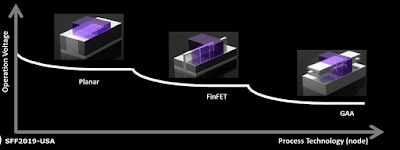 |
| Figure 1: Planar transistors vs finFETs vs nanosheet FET. Source: Samsung |
Topics: Applied Physics, Electrical Engineering, Moore's Law, Nanotechnology, Semiconductor Technology
So much for the Moore's law limit. Although under current circumstances, the progression might be stalled by our current viral situation: the cost of chips will go higher, and consumers are currently making choices on food, jobs and toilet paper, not gadgets.
Select foundries are beginning to ramp up their new 5nm processes with 3nm in R&D. The big question is what comes after that.
Work is well underway for the 2nm node and beyond, but there are numerous challenges as well as some uncertainty on the horizon. There already are signs that the foundries have pushed out their 3nm production schedules by a few months due to various technical issues and the unforeseen pandemic outbreak, according to analysts. COVID-19 has slowed the momentum and impacted the sales in the IC industry.
This, in turn, is likely to push back the roadmaps beyond 3nm. Nevertheless, the current climate hasn’t stopped the semiconductor industry. Today, foundries and memory makers are running at relatively high fab utilization rates.
Behind the scenes, meanwhile, foundries and their customers continue to develop their 3nm and 2nm technologies, which are now slated for roughly 2022 and 2024, respectively. Work is also underway for 1nm and beyond, but that’s still far away.
Starting at 3nm, the industry hopes to make the transition from today’s finFET transistors to gate-all-around FETs. At 2nm and perhaps beyond, the industry is looking at current and new versions of gate-all-around transistors.
At these nodes, chipmakers will likely require new equipment, such as the next version of extreme ultraviolet (EUV) lithography. New deposition, etch and inspection/metrology technologies are also in the works.
Needless to say, the design and manufacturing costs are astronomical here. The design cost for a 3nm chip is $650 million, compared to $436.3 million for a 5nm device, and $222.3 million for 7nm, according to IBS. Beyond those nodes, it’s too early to say how much a chip will cost.
Making Chips At 3nm And Beyond
Mark Lapedus and Ed Sperling, Semiconductor Engineering
Comments